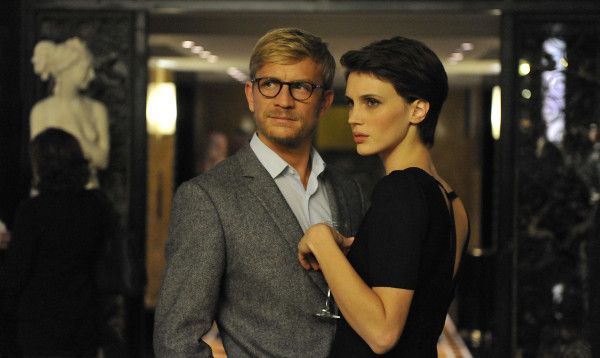Eye For Film >> Movies >> L'Amant Double (2017) Film Review

Fans of Seventies psychosexual thrillers - particularly Rosemary's Baby which receives several nods here and the films of Brian de Palma - will find much to enjoy in Francois Ozon's adaptation of Joyce Carole Oates Lives Of The twins, even if the story is as hokey as they come. He mentions the word "playful" more than once in the interview which accompanies the film's DVD release and that mindset is obvious from the start, when we are introduced to the film's main character first via a haircut and then by way of a cervix examination that cross cuts to her eye - a Buñuel in the oven, perhaps?
In fact, Chloé (Marine Vacth, channelling Mia Farrow with just a hint of Kristen Stewart) is told there is nothing physically wrong with her despite being borderline underweight. In a bid to solve her crippling stomach pains, she heads to a psychiatrist Paul Meyer (Jérémie Renier), a cosy cardiganed sort, and before you can say, "Psychiatryst", they're embarking on sessions of an altogether more intimate kind. Soon they're moving in together in an apartment complete with nosy, cake-making, cat-loving neighbour Rose (Myriam Boyer, in a Ruth Gordon-style scene-stealing turn) and Milo, Chloé's moggie, for which Paul harbours a thinly veiled dislike. Oh, and in one box, a passport that suggests there might be more to Paul than meets the eye.

Ozon is so slick you forgive the outlandishness of it all as Chloé stumbles upon Paul's twin Louis (Renier on double duty), another psychiatrist who has a much more hands (not to mention tongue) on approach to therapy. He also has a cat which, of course, he adores. As Chloé embarks on the twin relationships, her mental state begins to slip - if, indeed, it hasn't already - with much of the film's tension driven as much by the uncertainty that seeing everything from her skewed and unreliable perspective creates as by the difficulty of knowing which twin is which.
Fantasy and Freud are to the fore in the frequent sexual encounters but Ozon, who has always been interested in the full length of the sexual continuum, makes sure Chloé is pivotal and not just a plaything. It's also no accident that the museum exhibition where Chloé is a warden has the posters bearing the shlocky labels, 'Flesh' and 'Blood'. The director revels in the chance to multiply with mirrors, also creating surface symmetries between Paul and Louis's lives, while all the time suggesting that you need only dig a little deeper to see Louis is the more dangerous of the two. If there is rather more surface than substance and the ending is signposted, it is a surface full of mischievous intricacy and a signpost of admirable elegance. Ozon continues to be one of those directors who I'd put money on to make a silk purse out of a sow's ear.
Reviewed on: 09 Aug 2018
















